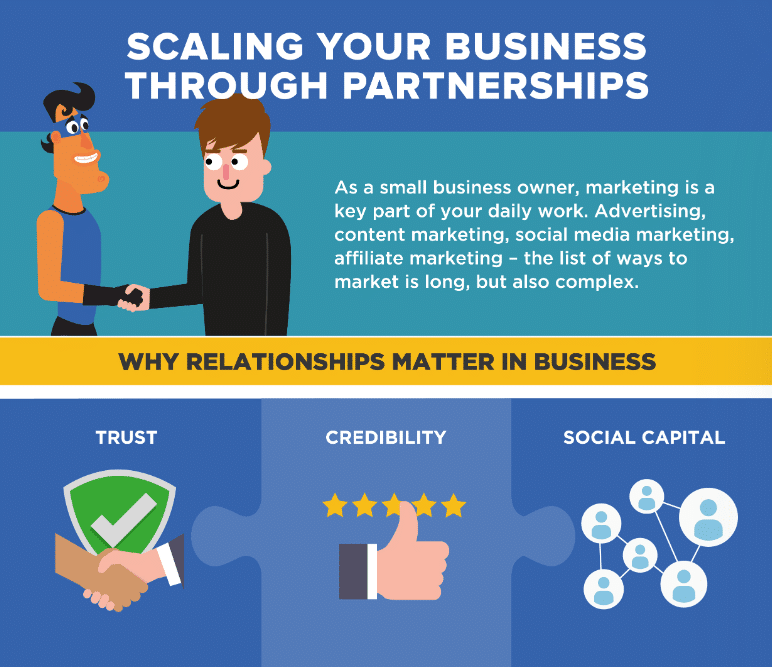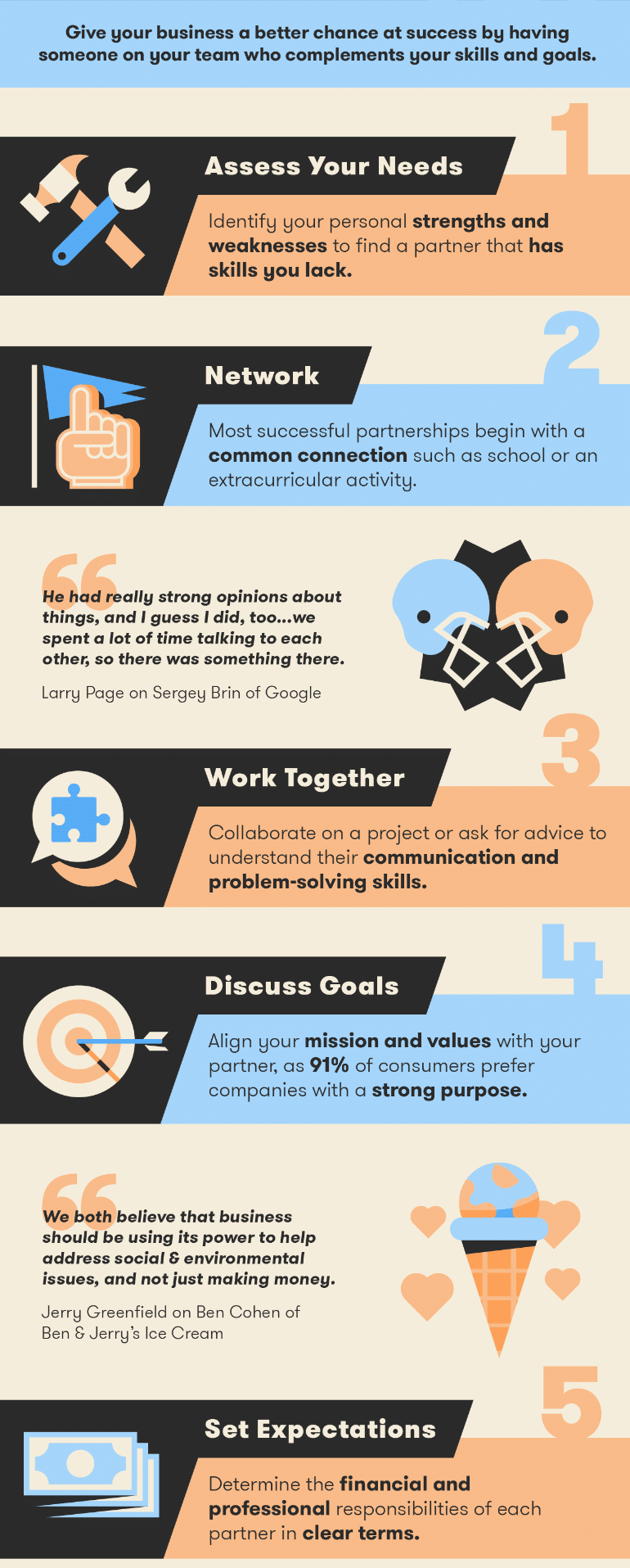Partnerships can be a game-changer for small businesses looking to take their business to the next level. The potential for business collaboration to raise a brand’s income may be the most evident benefit, since you can use resources that aren’t normally in your small business’ grasp.
Whether you’re looking to expand your customer base, increase revenue or gain access to new resources and expertise, partnerships can be a powerful tool for achieving these goals.
But before diving into a partnership, it’s important to ensure that you and your business are ready for the commitment. In this article, we will explore how to determine if your small business is ready for a partnership, uncover the benefits of small business partnerships, and provide tips for small businesses that want to start a partnership.
Get ready to discover the power of partnerships and how they could supercharge your small business.
Are you ready for a small business partnership?
Partnering with another business or individual can be a great way to grow your small business and reach new markets. However, before diving into a partnership, it’s important to ensure that you and your business are ready for the commitment.
Small businesses may not be ready for partnerships with bigger businesses, well-known creators, or groups of affiliates. But you might be able to form a partnership with another small business (or a smaller creator who wants to make money through their content).
Your small business should meet these criteria before starting a partnership:
First and foremost, your business should be established enough to have steady sales and a solid customer base. This will ensure you have the financial stability to invest in a partnership and make it a success.
Additionally, you should clearly understand the markets you want to reach through a partnership. This will help you identify the right partner for your business and ensure that your partnership aligns with your overall business goals.
Furthermore, it’s important to have a clear idea of the goals you want to accomplish through a partnership. This will help you measure the partnership’s success and make any necessary adjustments along the way.
Lastly, you should be willing to invest time and resources in a partnership. Partnering with another business or individual is a commitment and requires effort to maintain and grow the partnership.
If you don’t feel ready for a partnership, consider starting a small business referral program, where you invite your customers to share your business with their friends and family. This can be a great way to grow your customer base and increase awareness of your business without the added commitment of a partnership.
Benefits of small business partnerships
If you’re ready, partnering with another small business or creator can be a great way to achieve mutual goals and grow your business. Here are a few key benefits of partnering with another small business or creator:
- Helps you and another smaller business or creator accomplish mutual goals you couldn’t achieve on your own: By pooling resources, knowledge, and expertise, you and your partner can work together to achieve common goals.
- Increases brand awareness among a new and relevant audience: You’ll gain access to new markets and verticals. This can be especially beneficial if your partner has a strong following or a large network of contacts.
- You get the endorsement of another party, which helps you build trust and reputation: When a business partners with another, this counts as an endorsement of each others’ offerings. This can be a powerful way to build trust and credibility among potential customers.
- Both of you get to share resources: This can be especially beneficial if you have limited resources or a small budget, as is the case for many small businesses. By sharing assets, you can stretch your resources further and achieve more.
- Helps you (and your partner) generate leads and sales: This is especially beneficial if your partner has a reasonable customer base or a strong following. By working together, you can reach more potential customers and increase sales.
Small business partnership tips
It’s important to approach partnerships strategically to make the most of the opportunity. Here are a few tips to help you get the most out of your small business partnership:
Think about what you’d like to get out of the partnership
When considering a partnership, it is important to clearly understand what you want to achieve through the partnership. This could include reaching a new market, increasing visibility, driving social media engagement, and more. Identify what you want to achieve and what a partner can help you accomplish that you can’t achieve on your own. Additionally, think about any small businesses you already have a relationship with that could help you in this endeavor – they could make great partners if your goals and target markets are similar.
Look for partners that complement your business
It’s important to find a partner whose business complements yours. This means thinking about related, non-competing businesses where you could enhance each other’s offerings and naturally promote each other. A good example is a baby spoon brand partnering with a baby food brand, or a wedding planner partnering with a photographer.
Consider software
PRM (Partner Relationship Management) software can help any business communicate with and manage partners, regardless of size. The right software can generate sales links that you can use to track your partners’ sales. Additionally, you can use it to manage a customer-facing referral program and manage referral links. A portal can also be created where you can communicate with your partner and manage the partnership.
Referral Rock offers affordable PRM software that can manage all types of partnerships (plus customer referrals).With Referral Rock, you can easily communicate with and manage your partners, generate links to track sales, create a customer-facing referral program, and more. Plus, with our easy-to-use platform, you can get started right away.
Offer partnership incentives
Offering partnership incentives can encourage partners to work with you and help sell your products. These could be discounts on your products/services that they can offer to their network, help with their marketing campaigns, cross-promotion opportunities. Or, you can give incentives based on the sales your partner helps you make – these are ideal, because then you’ll only pay when the partnership returns results. Incentives don’t have to be monetary; you could give gifts when partners reach sales milestones. Software-created links can help you track sales and award incentives when earned.
Set mutual goals
Once someone agrees to a partnership, it’s important to determine each party’s goals. Be transparent about your goals and make sure they are open about theirs. Determine the markets and verticals you want to reach, discuss how you’ll measure whether you’ve achieved the goals, and set KPIs together. Discuss what steps each party is responsible for to accomplish these goals.
Form a partnership agreement
A partnership agreement holds each party accountable for their responsibilities and protects both parties in case someone engages in unethical activity. The agreement should include:
- Each party’s duties within the partnership
- Resources each of you will commit to the partnership (monetary and otherwise)
- Branding rules
- Terms for how your partner can and can’t promote your product
- Terms for how you can and can’t promote their products
- Strategies and tactics you’ll use to appeal to your target audience
- Incentives offered by each partner
Both parties should sign this written agreement before the partnership formally starts.
Regularly check in with partners
It’s important to keep in touch with your partner and ensure you both know how to reach each other if there are questions or concerns during the partnership. Schedule check-ins, whether in person or on Zoom, to discuss progress. If big decisions need to be made, discuss how to proceed together.
Look at your KPIs together and evaluate your progress; see what’s working well and where there’s room for improvement. Regular check-ins will also allow you to address any issues that may arise and make adjustments as needed.
Be flexible
Things can change quickly, especially for small businesses in this climate. This can affect the partnership and its success in meeting goals. If there are difficulties, you and your partner may need to revisit your plans and timelines or even redraft goals. If there are new opportunities, based on factors like changes in competitors or new leadership changes, be willing to pivot to take advantage of them. Flexibility allows you to adapt and make the most of new opportunities.
Conclusion
Partnerships can be a powerful tool for small businesses looking to grow and expand their reach. However, before diving into a partnership, it’s important to ensure that your business is ready for the commitment. By understanding what it takes to be ready for a partnership, the benefits it can bring, and tips for starting a partnership, small businesses can make informed decisions about whether a partnership is right for them and how to make the partnership a success.
Remember to set clear goals and expectations, choose the right partner, be open to new ideas, communicate effectively, and use the right tools. With the right approach, small business partnerships can be a powerful tool for driving growth and success.
If you’re looking for an affordable PRM solution to help you manage all types of partnerships (plus customer referrals), look no further than Referral Rock. Try Referral Rock today for free and see the difference it can make for your small business!






